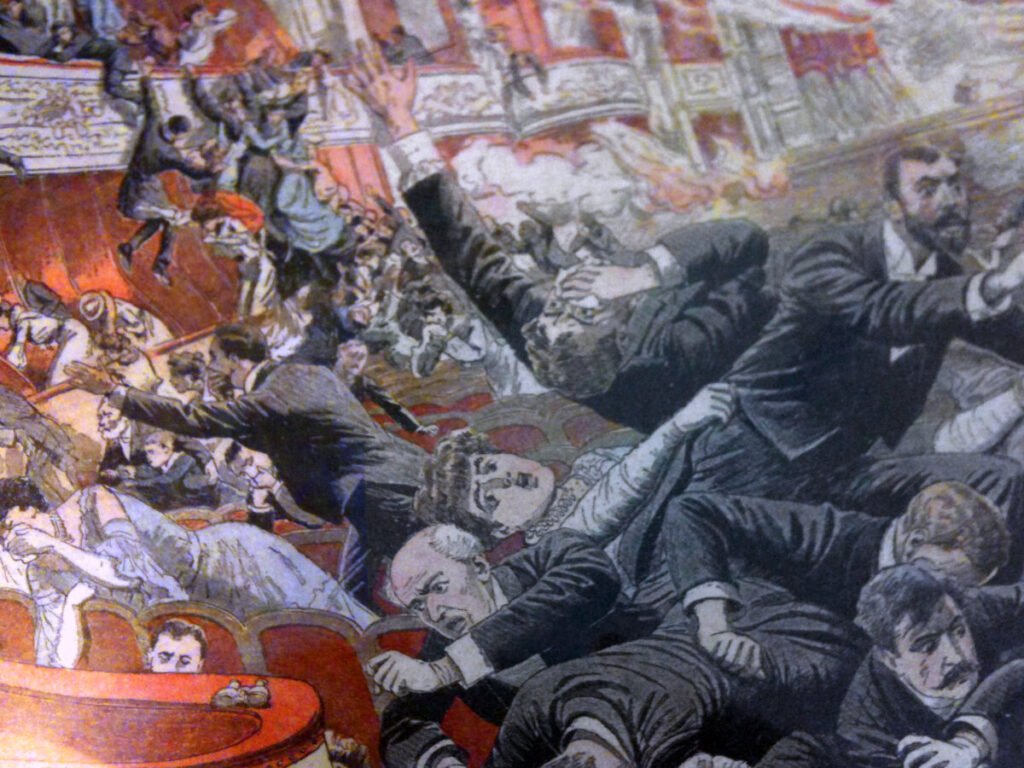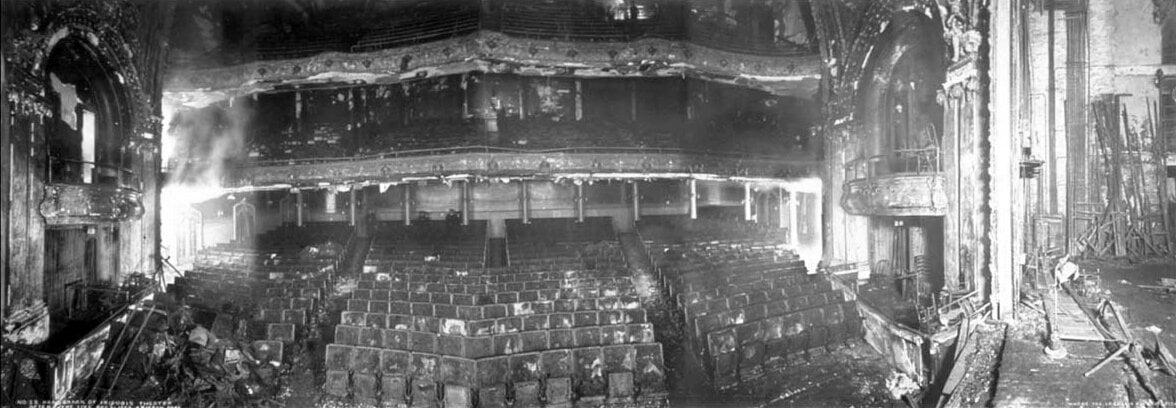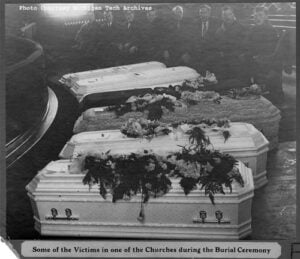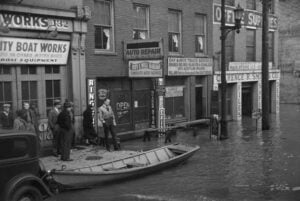The tragedy of the Iroquois Theater fire
The deadliest single-building fire ever recorded in the country.

exc-5fc037523f75b16643e5dad7
On December 30th, 1903, the Iroquois Theater, located in Chicago, IL, lit up in flames. It was the deadliest theater fire in US History. It was also the deadliest single-building fire ever recorded in the country. The fire killed over 600 people. (Most of them killed within 15 minutes). The tragedy of the Iroquois Theater Fire sent shockwaves across the country.
Actor Eddie Foy wrote in his memoirs, he saw in the upper levels a “mad, animal-like stampede – their screams, groans and snarls, the scuffle of thousands of feet and bodies grinding against bodies merging into a crescendo half-wail, half-roar.”
The Iroquois Theatre was built earlier that year. It was located at 24–28 West Randolph Street, between State Street and Dearborn Street, in Chicago, Illinois. The luxurious, Renaissance-style theater was designed in mind for wealthy individuals from Chicago and people traveling into town for a day trip.
Like the builders of the Titanic proclaiming the ship to be unsinkable, the owners of the Iroquois Theater bragged about the theater being fireproof. It wasn’t.
A fire department captain toured the theater before it opened. He noticed a lack of sprinklers, alarms, fire, and water hook-ups. There were also no telephones to make emergency calls. The captain told the theater’s fire warden about his worries. But the fire warden knew if he told the theater owner, the theater owner would fire him.
The layout of the theater was also problematic. The theater had one entrance. A large staircase was a violation of city ordinances requiring separate stairways and exits for each balcony. Two large vents in the ceiling, which could let fire and smoke escape, were boarded shut.
The theater did have an asbestos curtain, which was supposed to be a fire safeguard. However, a chemist later tested the curtain and discovered it was useless. The curtain was mainly wood pulp mixed with not enough asbestos to prevent it from catching fire.
The fire
During the afternoon of Wednesday, December 30th, the matinee of the popular “Mr. Blue Beard” play was on the schedule. Tickets were sold out. Hundreds of people had standing-room-only tickets, and the back of the theater and aisles were overflowing. Around 2,200 people attended the show. Many of the attendees were the wives and children of prominent Chicago businessmen.
The play began without any issues. Then, during the second act, an electrical short circuit caused sparks from an arc light to ignite a muslin curtain.
A stagehand armed with Kilfyre canisters tried to extinguish the flames. But the flames continued to spread to the flammable, canvas scenery. Blazing fabric rained down on the stage. The singers, including one with their costume on fire, fled. Eddie Foy, one of the production’s actors, spoke directly to the frightened audience trying to calm them. He also persuaded the orchestra to keep playing. Meanwhile, crew members tried lowering the “asbestos” curtain, but it snagged and the curtain was a few feet off the ground. The fleeing cast members opened up an outside door behind the stage. A draft blew through the doorway, which reached the spreading fire. It created a fireball that shot through the theater killing patrons in the inescapable balconies.
The fleeing audience
Audience members bolted towards the few exits in the theater. Locked, metal gates blocked multiple exits. The aisles became increasingly clogged. Women and children slammed into each other. The bodies started piling high, with patrons being crushed to death or dying of asphyxiation. (It’s said the bodies eventually were stacked 7-10 feet high) Foy wrote in his memoirs, he saw in the upper levels a “mad, animal-like stampede – their screams, groans and snarls, the scuffle of thousands of feet and bodies grinding against bodies merging into a crescendo half-wail, half-roar.”
Some audience members found an open fire escape in the upper level, but the ladder reaching the ground was missing. Men in the building across the alley, laid down narrow planks to create a bridge connecting the two buildings. The first two patrons to cross the makeshift bridge, raced across the planks before they slipped, falling to their deaths. Other emergency exits were unfinished, and multiple people slipped on the icy platforms. The first few people that fell broke the falls of the people that fell after them.
Firefighters arrive
Because the theater didn’t have a fire alarm or telephone. A stagehand had to run to the fire station to notify the firefighters. By the time the firefighters entered the building, 575 people were dead. (The fire actually killed more people than the Great Chicago Fire, which decimated the city).
The fire chief, Marshall Campton entered the building and noticed an eerie silence.
“Is there any living person here?” the marshal shouted again and again.
The cry echoed through the silent place and no voice answered.
Once more he shouted, “If any one here is alive, groan or make some sound. We’ll take you out.”
Around the same time, looters had started stealing rings, bracelets, watches, money, and more from the dead bodies. The thieves even ripped out pearl earrings from the ears of the dead women.
The authorities took over the next-door diner and transformed it into a makeshift field hospital and a morgue. News spread across the city and family and friends of the dead raced to the scene, hoping to find their loved ones alive.
A few days after the fire, the Chicago Tribune published a damning list of all the Iroquois Theater’s flagrant, fire violations. The newspaper called for action: “The only atonement that can be made to these hapless victims of negligence is to make the theaters of Chicago absolutely safe, so that none others may meet their fate.”
Anger spread throughout the city. Advertised as being “fireproof”, the theater failed the fireproof test in almost every way possible.
The mayor shut down all the Chicago theaters for six weeks.
Legal repercussions
There were numerous legal repercussions for the fire. The theater owners were sued individually for 575 counts of manslaughter.
The mayor, Carter Harrison, was also charged. There were allegations that the fire inspectors were bribed with free tickets to overlook the numerous code violations. Because the mayor’s City Commissioner of Buildings didn’t even inspect the building, it was charged that Mayor Harrison was liable. But the Mayor knew about the theater’s violations. The mayor was informed a month before the fire, the violations were so numerous it was impossible to enforce them. However, Mayor Harrison was eventually released under habeas corpus and was absolved of any liability charges.
Most of the charges related to the fire were thrown out, except charges against a saloon owner. The saloon owner robbed the dead bodies while they sat in his saloon which served as a makeshift morgue.
New safety precautions
The theater fire made headlines across the nation. The fire led to new laws being implemented in theaters and high-occupancy buildings throughout the country. Fire exits with panic bars were installed. Actual asbestos curtains were implemented in theaters. The ordinances the Iroquois Theater broke were enforced and taken more seriously.
The theater site today
The fire largely undamaged the theater’s exterior. It later reopened as the Oriental Theater. In 1925, the theater was demolished and replaced by the opulent Oriental theater, which is now called Nederlander Theatre.
Sources:
https://www.chicagotribune.com/nation-world/chi-chicagodays-iroquoisfire-story-story.html
https://florencekelley.northwestern.edu/historical/iroquois/







